Friday, July 07, 2006
Os, Lyse Kloster, & Fana, July 5
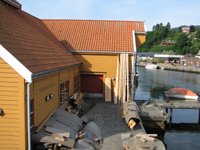


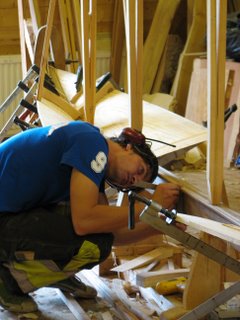


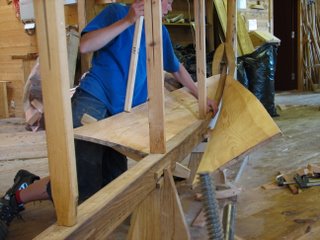



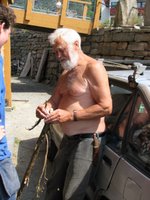
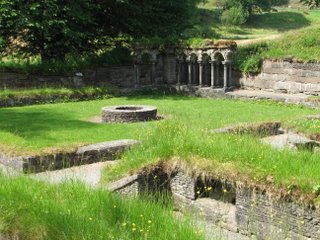

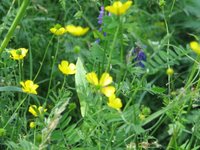
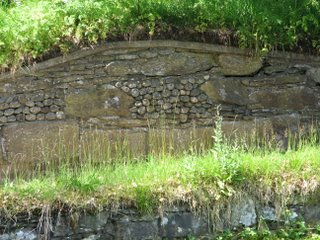
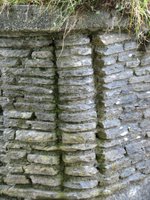
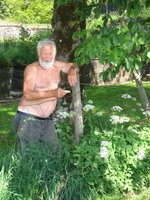
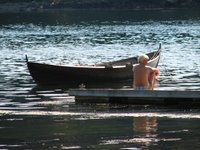
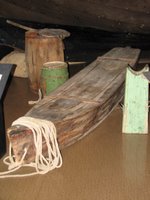

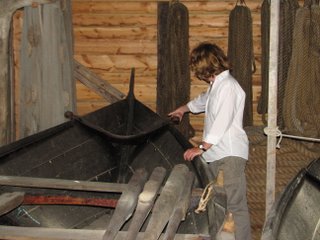
I was on the 8 am bus to Os about an hour south of Bergen to see another traditional boatbuilding workshop, the Oselvarverkstaden (Oselvar Boat Yard). I circled the building a few times because it seemed pretty still, but then a door opened. There are three apprentice boatbuilders there now, and they are each making a færving. The Oselvar færving that is being built here is very close to the Hardanger færving being built at the Hardanger Fartøyvernsenter in Norheimsund. In fact, these four-oar rowing and sail boats are very close to the ones found in on the Gokstad Ship in the Viking burial mound from the 9th century. This structure has been used for over one thousand years, and there are archeological findings of parts of these same clinker built boats up to 2000 years old.
Now they use machines to speed up certain processes, but depend largely on hand tools, especially the axe, for the most part. When they are making the "T" shaped keel out of oak, they are now making an undercut on the tablesaw at a 12 degree angle. They waste out the part under the arms of the "T" by overhanging the stick on the jointer and rabbetting out the waste. Slick trick! Get that darned guard of the jointer people!
But being a builder of traditional wooden boats in Norway still means taking a lot of care and patience in wood aquisitionand selection. We thought we took our time at College of the Redwoods, pulling every choice plank out of the wood room and carefully inspecting the color and grain figure. This is different though. They spend about 2 weeks every year up in the forest looking at trees that have the right curves, and ones that are old, slow grown, wide trees that can provide them with the very broad and tight-grained planks needed to make a boat with just 3 strong strakes. The trees are milled with a portable saw mill and the wood is brought to the boathouse. Most of the boat is pine, but the parts used for the stem and stern and keel are oak. The oak is put into a pen under the dock. It will sit there for three years, underwater when the tide is high. The Air exposure during low tide protects the wood from getting attacked by shipworms. After three years, the oak is more soft and workable, and much of the tension has been released so that the oak is very stable. It is then air dried for another year. A lot of space is dedicated to wood storage here.
Both of the apprentices working on their boats that morning were in the middle of their boats, so I could really see the process. Berit Osmundsen, a woman from the Lofoten Islands, was finishing shaping the halsen with a hand plane. Maik Riebort, a man living in Berlin who is also a film student and a dancerwhen he is not a boatbuilding apprentice in Norway, was making the flatter boards that join up the halsen. He said this is the easiest part in the whole boat.
I love seeing how the boats are built in place, and how they are braces and fixed in place with sticks from the floor and low ceiling beams pushing the boat planking into tension and compression. With this system, the builder had a lot of fine control over the exact angles and shapes the boards take. It is very practical and effective, and they do not have to sit around doing trigonometry on thier calculators (as I am prone to do).
OK, that's it! I'm becoming a boatbuilder! Get me an axe!
Another reason to become a Norwegian woodworker: the blue pants. All of the carpenters wear them here, sort of like Carhartts. But these have all of these auxillary pockets like wearing an apron, plus they have these foam insert knee pads. I told Berit that I had to have some blue pants. She happened to have a pair left by an ex-boyfriend that were the right size and price for me. We just had to find a ride to her house.
Luck would have it that a retired gentleman had stopped by for lunch. He often came to the boathouse for a little society around lunchtime. He was wearing no shirt and ratty pants. He had been fishing all morning and had four or five big fish with him. He really wanted to give me one, but I thought better of it considering I was doing a lot of riding on the bus and it was quite hot out. The man, Andor, gave us a ride to the blue pants. He thought it was a shame that I should have to take two busses and do some backtracking in order to get to my next stop, Fana, so he offered to drive me to another stop.
Well, he spoke very little english, and I speak very little norsk. I tried to understand the plan, but ended up just saying "OK" a lot. We stopped at some ruins at Lyse Kloster that are dated 1146. These are fantastic, but they are not in either of my guidebooks. Andor ransacked his cluttered car for a brochure for me while I climbed up the low, fat walls of the ruins and hopped over doorways. Like other places I have been outside the States, the ruins were no more protected from me than I was from them. That's much more fun. Some of my favorite parts were the places in the stone walls where the rack sizes were mixed up, so there would be a lot of small, flat raock and then a patch of rounded cobbles mixed in.
The only other folks around were a woman and her school-aged son. By the time I had returned from taking pictures and exploring, Andor had stuck up a conversation with this woman. He managed to get her to take a fish home.
Andor is quite a character. He is enthusiastic, friendly, generous, chatty, and hard to shake. He is a free spirit, so he sometimes drives on the right side of the road, but he likes to mix it up by driving in the middle and on the left too. The gutter is not off limits either. Between his driving style and his interest in showing me the region, I wondered if I would get to the museum where I had an afternoon appointment. But Andor did deliver me to Fana and the Horda Museum, right to the front steps. He drove right through the detour tape that had been strung tight across the road to do so. He seemed to know the people here too. He came into the museum with a warm bottle of beer and procured 2 glasses from the cafe. He still had no shirt on, by the way. We split the beer. He explained that it was the same temperature as our bodies, which was a good thing so that we would not go into shock. Right. Andor stuck around for quite a while making new friends even after I took off with the archeologist, Ole Mikal Olsen. I won't soon forget Andor.
The Horda Museum in Fana had an interesting object that I really liked: a fish coffin. It is a boat shape with open slits and a lid. It would hold live fish that fishermen were towing back to the market. The main thing that the Horda Museum houses is a large collection of old boats in storage sheds. Ole is very knowledgable about the history of these boats, and he took me around to see them. These boats were again quite similar to the ones I had seen at the boatyards, but some of these were with more pairs of oars, up to 10 oars (ti-ærving). Ove told me that in the oldest boats found, instead of having iron clinkers holding the planks together, they were actually tied with roots.
Some of the boats in the Horda collection had been used for fishing, but others had been church boats used only to go to church. These were very finely crafted with small details, and they were in mint condition due to their low milage.